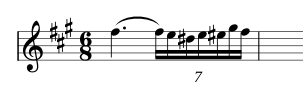5.4. Tuplets
A tuplet is a group of notes whose duration is modified; normally a graphic element (a tuplet bracket and/or a number) marks this group of notes. The notes in a tuplet are usually beamed together but this is not always the case.
Important
The tuplet information is splitted for distinguish between graphical information and notes’ duration modification information. The tuplet element is only for defining the graphical information (presence of tuplet bracket and numbers). The notes’ duration modification information is independently provided by the timeModification element.
In LDP, to specify the notes that form a tuplet, a tuplet element must be included in first and last notes in the tuplet:
tuplet ::= (ttupletID{ - | +actualNotesnormalNotes[tupletOptions] }) tupletID ::= integer_number actualNotes ::= integer number normalNotes ::= integer number tupletOptions ::= noBracket [displayBracket] [displayNumber] displayBracket ::= (displayBracket { yes | no }) displayNumber ::= (displayNumber { none | actual | both })
The tupletID element was introduced for uniquely identifying each tuplet,
mainly to distinguish nested tuplets.
The tuplet type is a plus sign (+) or a minus sign (-) to indicate, respectively, that it is the start or the end of a tuplet.
The displayNumber option is used to display the number of normal notes. By default, only the actual notes number is displayed.
The displayBracket option is used for controlling whether to display or not the tuplet bracket. If unspecified, the default behaviour follows the usual engraving rules: the bracket is not displayed if the tuplet notes form a beamed group.
Examples:
(score (vers 2.0) (instrument (musicData
(clef G)
(time 2 4)
(n c4 e (t 1 + 3 2)(tm 2 3))
(n d4 e (tm 2 3))
(n e4 e (t 1 -)(tm 2 3))
)))

This example is a triplet of eighth notes. Element (t 1 + 3 2) in first note
declares the triplet: it is tuplet number 1; the plus sign says that this note is the start of the tuplet; and
numbers ‘3 2’ declare that three notes must be played in the time alloted for two notes. The end of the tuplet
is declared in last note: (t 1 -). The tuplet element is just used for defining the graphic elements: the bracket and the 3 number. But has no any effect on the notes duration. For that, a timeModification element (tm 2 3) must be included in each note:
timeModification ::= (tmnumeratordenominator) numerator ::= integer number denominator ::= integer number
The timeModification element must be included in all the notes that form the tuplet. The time modificaction information is a multiplication factor to be applied to normal note/rest duration. This factor is defined, as a fraction, by its numerator and denominator. The timeModification element is independent of the tuplet and can be of utility in other situations. For instance, in jazz scores, to alter notes duration when they must be played with swing.
The tuplet element does not implies neither beaming nor time modification. Therefore elements tuplet, timeModification and beam must be combined as needed.
Example 1:
(score (vers 2.0) (instrument (musicData
(clef G)
(time 2 4)
(n c4 e (t 1 + 3 2)(tm 2 3)(beam 1 +))
(n d4 e (tm 2 3)(beam 1 =))
(n e4 e (t 1 -)(tm 2 3)(beam 1 -))
)))

Example 2:
(score (vers 2.0) (instrument (musicData
(clef G)
(key A)
(time 6 8)
(n f5 q. (tie 1 start))
(n f5 s (tie 1 stop)(tm 6 7)(t + 7 6)(beam 1 ++))
(n e5 s (tm 6 7)(beam 1 ==))
(n +d5 s (tm 6 7)(beam 1 ==))
(n e5 s (tm 6 7)(beam 1 ==))
(n +e5 s (tm 6 7)(beam 1 ==))
(n g5 s (tm 6 7)(beam 1 ==))
(n f5 s (tm 6 7)(t -)(beam 1 --))
(barline)
)))
